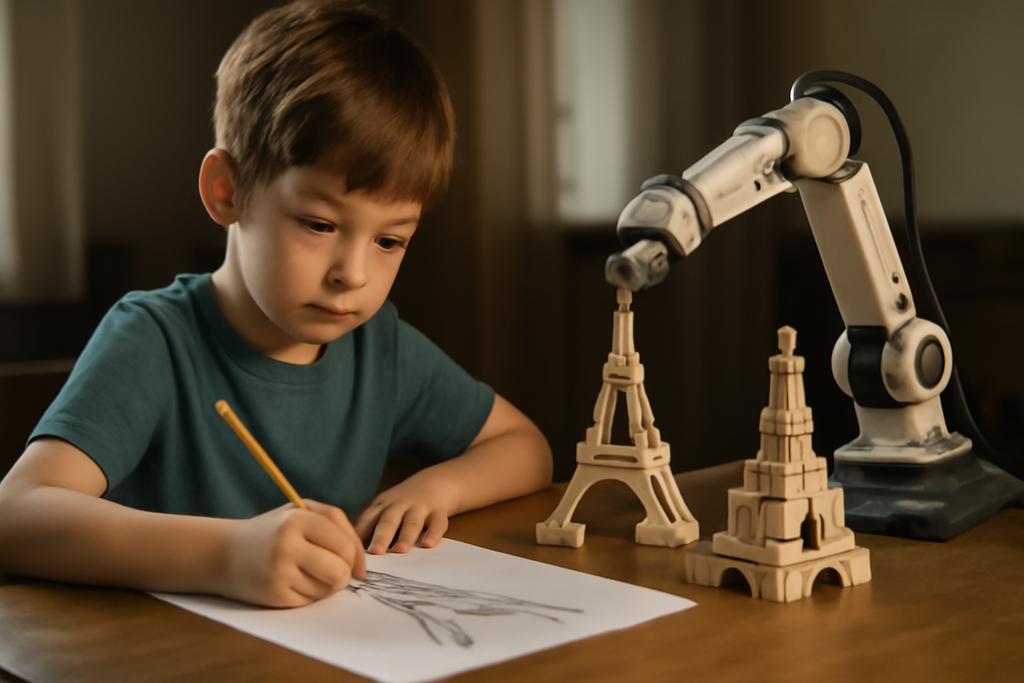From Scribbles to Structures
Picture a child drawing the Eiffel Tower with a few rough lines and then asking a robot to build it. For humans, this leap from a simple 2D sketch to a towering 3D structure is almost intuitive. But for robots, it’s a puzzle wrapped in ambiguity. They need exact 3D coordinates and detailed blueprints before they can even think about stacking blocks or assembling parts. This gap between human creativity and robotic precision has long kept robots from understanding our spontaneous, imperfect drawings.
Researchers at the National University of Singapore, led by Yiqing Xu and colleagues, have developed a system called StackItUp that bridges this divide. It lets anyone—no CAD expertise required—turn a hand-drawn 2D sketch into a stable, multi-level 3D structure that a robot can physically build. This isn’t just a fancy trick; it’s a step toward making robots more accessible collaborators in design, education, and construction.
The Challenge of Turning Flat Lines into Stable Forms
Why is this so hard? First, hand-drawn sketches are messy. Lines might be crooked, proportions off, and crucially, a front-view sketch hides what’s behind or inside the structure. Imagine drawing a bridge: the sketch shows the top and sides but not the hidden supports underneath that keep it from collapsing. Robots need to infer these invisible supports to ensure the final build won’t topple.
Second, the robot’s world is three-dimensional and governed by physics. It can’t just stack blocks anywhere; each piece must be precisely positioned so the entire structure withstands gravity. This means the system must predict exact 3D poses for every block, including those not even hinted at in the sketch.
Abstract Relation Graphs: The Secret Language Between Sketch and Structure
StackItUp’s genius lies in its use of an abstract relation graph. Think of this graph as a symbolic blueprint distilled from the sketch. Instead of obsessing over exact measurements, it captures the essence of the design through qualitative relations like “left-of,” “supported-by,” or “two-pillar-bridge.” This abstraction filters out the noise and focuses on how blocks relate spatially and structurally.
For example, if the sketch shows two pillars supporting a bridge block, the graph encodes this as a “two-pillar-single-top-bridge” pattern. These patterns are not just geometric niceties; they encode physical stability principles that guide the robot in adding hidden supports where the sketch is silent.
Compositional Diffusion Models: Piecing Together the Puzzle
Once the abstract relation graph is extracted, StackItUp uses a set of specialized AI models called compositional diffusion models to generate the 3D poses of all blocks. Each model is trained to handle a specific type of relation or stability pattern. By composing these models, the system can jointly predict a coherent 3D arrangement that respects all the encoded relations.
But the process doesn’t stop there. The system simulates the structure’s stability under gravity. If it detects instability—say, a block is overhanging without support—it goes back and updates the graph by adding hidden blocks and relations to shore up the weak spots. This iterative forward-backward dance continues until the structure stands firm.
Why This Matters Beyond Robotics
StackItUp’s approach is more than a clever algorithm; it’s a new way to democratize 3D design and robotic assembly. By allowing users to communicate with robots through simple sketches, it lowers the barrier for creative expression and practical construction. Imagine architects sketching rough concepts that robots instantly translate into physical models, or educators using this tool to teach engineering principles interactively.
Moreover, the system’s ability to infer hidden supports tackles a fundamental challenge in design: the unseen forces and structures that make everything hold together. This mirrors how humans intuitively understand architecture and physics but machines often stumble on.
Surprising Insights and Future Horizons
One striking finding is how much better sketches are than natural language at conveying spatial and structural intent. The researchers compared StackItUp to systems that translate text descriptions into 3D models and found that sketches preserve geometric details that words often miss. This underscores the unique power of visual communication in human-robot interaction.
Another surprise is the robustness of the abstract relation graph. It allows StackItUp to generalize zero-shot—that is, to handle sketches it has never seen before, including complex landmarks like Marina Bay Sands or the Taj Mahal. This flexibility comes from focusing on relations and patterns rather than memorizing specific shapes.
Looking ahead, the team envisions extending StackItUp to handle multiple sketch views, integrate perception to identify block types automatically, and incorporate real-time feedback from robots during assembly. These advances could make the system even more intuitive and powerful, turning robots into true partners in creative construction.
Building a Future Where Robots Understand Our Scribbles
StackItUp is a vivid example of how AI and robotics can embrace human imperfection and creativity rather than demanding rigid precision. By translating rough sketches into stable 3D structures, it opens the door to a world where anyone can design and build with robots, no technical training required.
In a way, it’s like teaching robots to read between the lines—literally—and to fill in the blanks with common sense and physics. This blend of symbolic reasoning and generative modeling could reshape how we interact with machines, making them more accessible, responsive, and creative collaborators.
So next time you doodle a tower or a bridge, remember: the future might just have a robot ready to bring your sketch to life.










